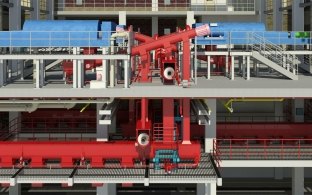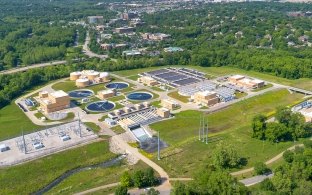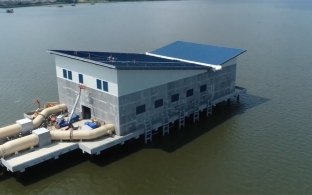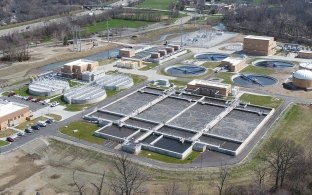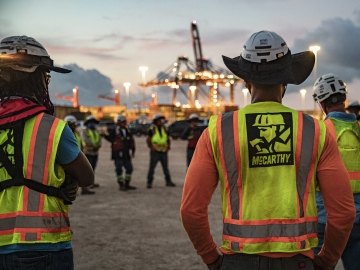City of Pearland Breaks Ground on Barry Rose Water Reclamation Facility Replacement and Expansion, and Longwood Water Reclamation Facility Decommissioning
The project is comprised of three phases to accommodate the expansion and redirection of flows from Longwood WRF to Barry Rose WRF, without impacting plant operations.
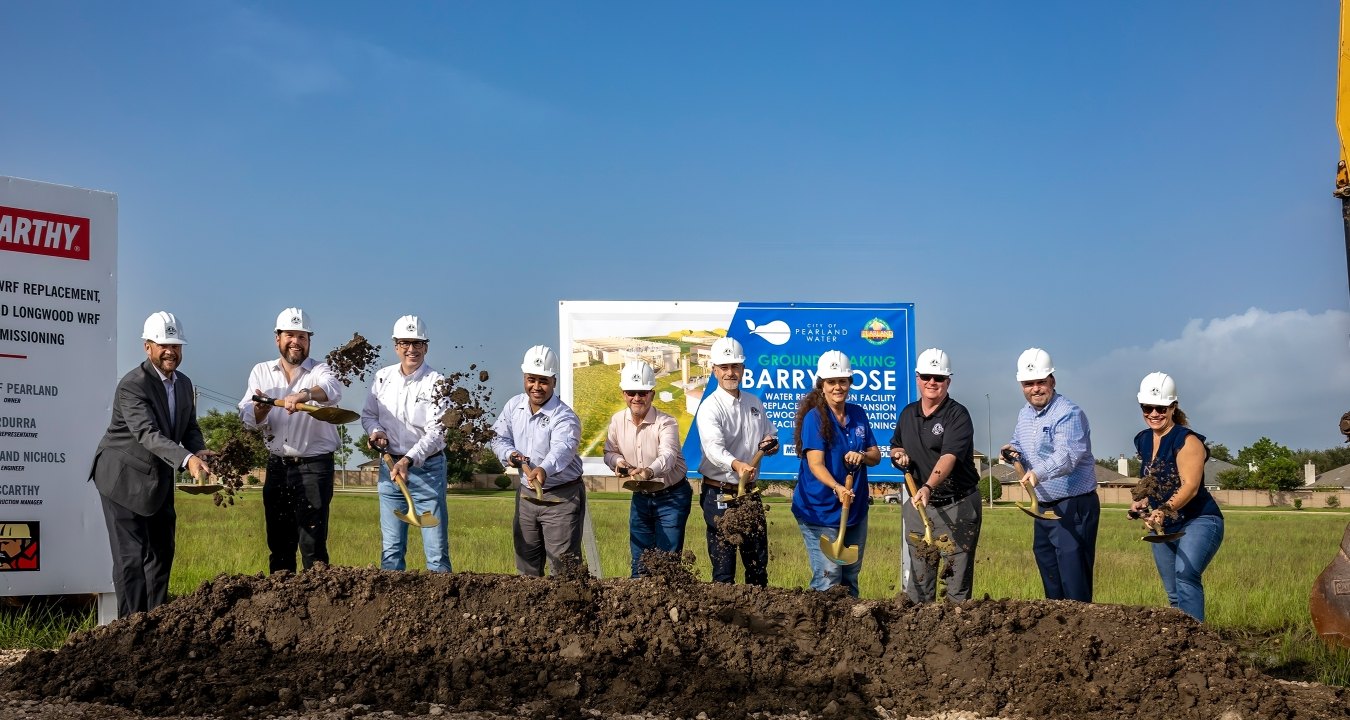
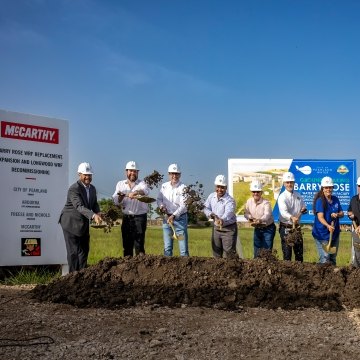
The City of Pearland broke ground on the expansion of the Barry Rose Water Reclamation Facility (WRF) Replacement and Expansion project, which will increase the plant’s wastewater treatment capacity from 3.1 million gallons per day (MGD) to 5.0 MGD to better address the community’s growing needs.
The $216.7 million construction project expands and updates the 50-year-old Barry Rose Water Reclamation Facility’s infrastructure while also decommissioning the neighboring Longwood WRF, rated at 2.5 MGD, to mitigate the risks of aging infrastructure and increase the city’s wastewater collection and treatment efficiency. The expansion project is scheduled to be completed in early 2028.
After years of collaborative planning efforts between the City’s Engineering & Public Works Department, Pearland Water, and the project’s construction team, the City of Pearland City Council authorized the approval of a construction contract for this project on June 24, 2024. McCarthy Building Companies, Inc. (McCarthy) was named as the project’s general contractor, serving as the Construction Manager at Risk (CMAR), in partnership with the project’s design engineer Freese and Nichols, Inc., and Ardurra, which is serving as the city’s advisor on the project. On July 31st a groundbreaking ceremony marked the beginning of construction for these two projects, which will assist the city in responsibly serving its residents and businesses with wastewater for years to come.
Expansion of the Barry Rose WRF involves the use of updated wastewater treatment technologies, including sequencing batch reactors (SBR), solids handling and UV disinfection. The expansion at Barry Rose and the lift station at Longwood will also incorporate equipment and technology that is uniform with Pearland’s other large treatment facilities and will make operation and maintenance more efficient.
“Through updating aging infrastructure and bringing uniform equipment and processes across the city’s facilities, the City of Pearland is positioning itself to reduce operating cost and provide long-term, consistent benefits to residents,” said McCarthy project director Aaron Moss. “Our project team experts have been collaborating with the City and sharing insights during the design phase of this project to ensure the stage is set for construction to begin - we’re right on track and look forward to continuing to make seamless progress.”
The Barry Rose WRF expansion includes addition of a new influent lift station, headworks, a six-basin Sequencing Batch Reactor structure, a non-potable water system, and other site utility, piping and security improvements. The construction project also involves building several new structures on the existing site, including a two-story belt filter press dewatering facility, Aerated Sludge Holding Tanks and a retention pond.
“It’s exciting to see this project moving quickly to keep pace with the City’s needs,” said David Munn, Freese and Nichols’ group manager for water/wastewater treatment in the western Gulf Coast region. “As Pearland residents ourselves, our team members are doubly invested in these infrastructure improvements. We value our strong partnership with the City and McCarthy that’s making this progress possible.”
The project is comprised of three phases to accommodate the expansion and redirection of flows from Longwood WRF to Barry Rose WRF, without impacting plant operations. Phase I includes grading and the expansion of Barry Rose’s site drainage, while also establishing a detention pond and constructing the sequential batch reactor (SBR) structure.
Phase II, which is scheduled to begin in January 2025, will focus on the wastewater processing structures at Barry Rose and constructing a regional lift station, to replace the existing Longwood WRF, that will send the plant’s flows to the new Barry Rose WRF. Phase III, which is slated to begin in May 2025, will include installation of a five-mile force-main pipeline to connect the new Longwood regional lift station to the Barry Rose WRF, followed by start-up and commissioning of the updated facility. Once flows are transferred, the project team will demolish all remaining outdated Barry Rose WRF and Longwood WRF infrastructure.
Through merging the flows of the two plants into one, the City of Pearland is consolidating operating costs while prioritizing the upgrading and maintenance of water infrastructure to one centralized plant. With the Barry Rose WRF currently operating at approximately 60% treatment capacity, the rapid population growth has expedited the need for plant expansion, according to Texas Commission on Environmental Quality (TCEQ) regulations.
The Barry Rose WRF expansion is expected to reach its new treatment capacity in June 2027, with all final demolition and decommissioning of the Longwood WRF completed by early 2028.
McCarthy’s national Water and Wastewater team has completed or is in the process of constructing more than 70 major collaborative delivery water and wastewater projects in communities throughout the U.S. over the past two decades.
About the City of Pearland
Pearland, one of the fastest growing cities in Texas, is characterized by its affordable housing, outstanding schools, safe neighborhoods, and vast recently constructed retail, office, and residential spaces. Just a 20-minute drive from downtown Houston, Pearland is quickly becoming the next major employment center in the region. However, Pearland's history goes beyond the initial founding date. Native Indian inhabitants hosted their first European visitors in 1528 including such famous names as Cabeza de Vaca, La Salle, and Stephen F. Austin leap out from this tumultuous chapter in Texas' colorful history that traces the area's development to present-day Pearland. The tenacity of these early settlers formed the backbone of a thriving community that continues to grow, increasing from approximately 19,000 to more than 100,000 residents in the last 2 decades.
About McCarthy
McCarthy is the oldest privately held national construction company in the country – with nearly 160 years spent collaborating with partners to solve complex building challenges on behalf of its clients. With an unrelenting focus on safety and a comprehensive quality program that spans all phases of every project, McCarthy utilizes industry-leading design phase and construction techniques combined with value-add technology to maximize outcomes. Repeatedly honored as a Best Place to Work and Healthiest Employer, McCarthy is ranked the 19th largest domestic builder (Engineering News-Record, May 2024). With approximately 6,000 salaried employees and craft professionals, the firm has offices in St. Louis; Atlanta; Collinsville, Ill.; Kansas City, Kan.; Omaha, Neb.; Phoenix; Las Vegas; Denver; Austin, Channelview, Dallas, and Houston, Texas; and San Diego, Newport Beach, Los Angeles, San Francisco, San Jose and Sacramento, Calif. McCarthy is 100% employee owned. More information about the company is available online at www.mccarthy.com or by following the company on Facebook, LinkedIn and Instagram.
About Freese and Nichols, Inc.
Freese and Nichols plans, designs and manages water and infrastructure projects across the United States with a focus on innovative and sustainable solutions. Founded in 1894, our privately owned firm offers stability as a long-term trusted advisor and uses our national expertise to meet contemporary challenges. We are the first engineering/architecture firm to earn the Malcolm Baldrige National Quality Award.
Photo Credit: Slyworks Photography



